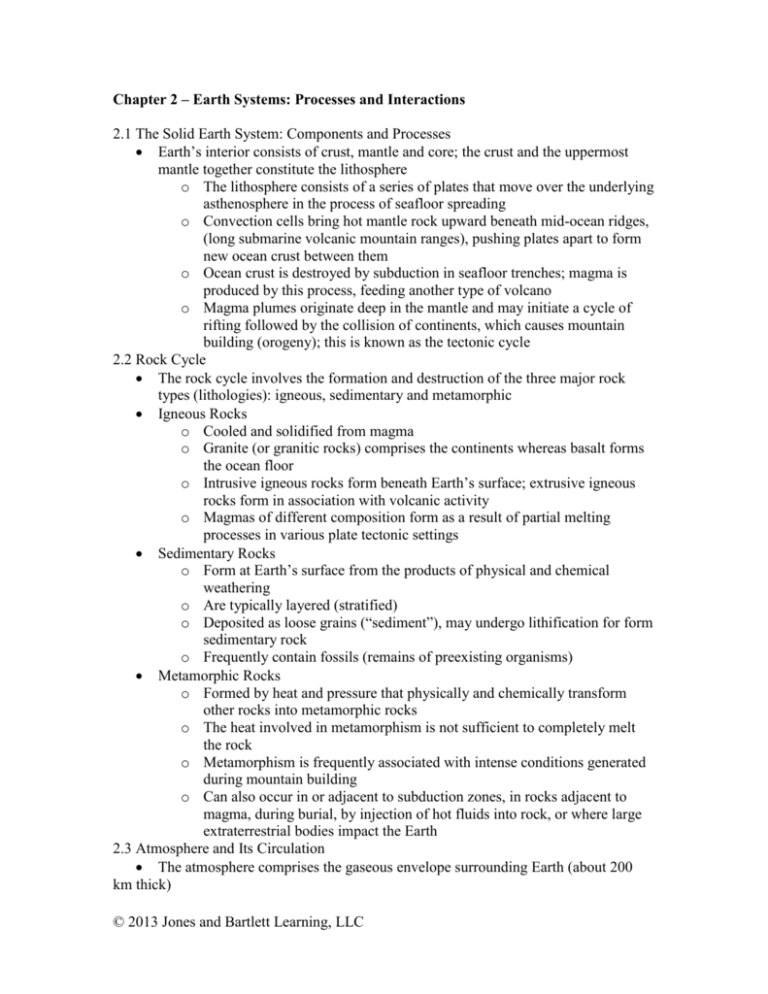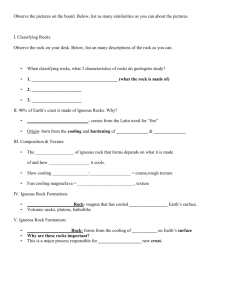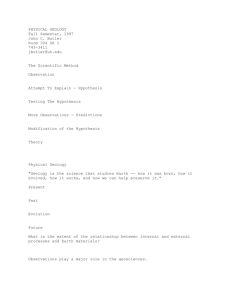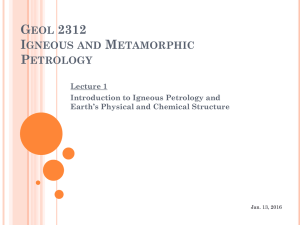Chapter 2: Earth Systems: Processes and Interactions
advertisement

Chapter 2 – Earth Systems: Processes and Interactions 2.1 The Solid Earth System: Components and Processes Earth’s interior consists of crust, mantle and core; the crust and the uppermost mantle together constitute the lithosphere o The lithosphere consists of a series of plates that move over the underlying asthenosphere in the process of seafloor spreading o Convection cells bring hot mantle rock upward beneath mid-ocean ridges, (long submarine volcanic mountain ranges), pushing plates apart to form new ocean crust between them o Ocean crust is destroyed by subduction in seafloor trenches; magma is produced by this process, feeding another type of volcano o Magma plumes originate deep in the mantle and may initiate a cycle of rifting followed by the collision of continents, which causes mountain building (orogeny); this is known as the tectonic cycle 2.2 Rock Cycle The rock cycle involves the formation and destruction of the three major rock types (lithologies): igneous, sedimentary and metamorphic Igneous Rocks o Cooled and solidified from magma o Granite (or granitic rocks) comprises the continents whereas basalt forms the ocean floor o Intrusive igneous rocks form beneath Earth’s surface; extrusive igneous rocks form in association with volcanic activity o Magmas of different composition form as a result of partial melting processes in various plate tectonic settings Sedimentary Rocks o Form at Earth’s surface from the products of physical and chemical weathering o Are typically layered (stratified) o Deposited as loose grains (“sediment”), may undergo lithification for form sedimentary rock o Frequently contain fossils (remains of preexisting organisms) Metamorphic Rocks o Formed by heat and pressure that physically and chemically transform other rocks into metamorphic rocks o The heat involved in metamorphism is not sufficient to completely melt the rock o Metamorphism is frequently associated with intense conditions generated during mountain building o Can also occur in or adjacent to subduction zones, in rocks adjacent to magma, during burial, by injection of hot fluids into rock, or where large extraterrestrial bodies impact the Earth 2.3 Atmosphere and Its Circulation The atmosphere comprises the gaseous envelope surrounding Earth (about 200 km thick) © 2013 Jones and Bartlett Learning, LLC o Helps warm Earth through greenhouse effect; also shields planet from cosmic radiation o The modern atmosphere is mainly composed of nitrogen (78%) and oxygen (21%); carbon dioxide comprises only a trace amount (0.038%) o Carbon dioxide and water vapor both contribute to warming the Earth Atmospheric circulation is driven by the temperature contrast between the equator and poles o This contrast results from different fluxes of solar radiation reaching Earth’s surface o The atmosphere attempts to “smooth out” this temperature gradient by transferring heat from the equator toward the poles by convection o Earth’s wind patterns result from the effects of atmospheric convection combined with Coriolis effect (due to Earth’s rotation) 2.4 The Hydrosphere Hydrologic Cycle – involves the flux of water through several reservoirs o Precipitation may be lost through evaporation, may flow on Earth’s surface as runoff (until reaching the oceans), or may infiltrate the ground (and become groundwater) o Water is used by plants (part of the biosphere), which lose large amounts through their leaves (transpiration) o Ice may be described as a separate Earth system from the hydrosphere, the cryosphere Ocean Circulation – the oceans are the dominant component of the hydrosphere o Oceans cover 70% of Earth’s surface and average 3.8 km in depth o They store 96.5% of Earth’s water, account for over 86% of all evaporation, and receive 78% of all precipitation o Water’s high heat capacity makes the ocean the largest reservoir and regulator of heat on Earth, and therefore a major influence on climate o Earth’s wind systems drive the major surface currents (gyres) under the influence of Coriolis effect o The deep water masses circulate somewhat more slowly in the “oceanic conveyor” (meridional ocean circulation) o Density differences between water masses (due to temperature and salinity) play a role in their movement o Oceans also affect Earth’s albedo (surface reflectivity) because they are dark and thus radiate solar energy as heat 2.5 The Biosphere Biogeography: Distribution of Plants and Animals Over Earth’s Surface o The biosphere consists of the total living biota (organisms) of Earth o Organisms are not uniformly distributed; instead, each type (species) has a certain range of physical environmental factors within which it can live and reproduce o This tolerance to environmental factors determines the biogeographic distribution of different species o On land, regions are characterized by biomes; in the ocean, various provinces are distinguished © 2013 Jones and Bartlett Learning, LLC o Each continent or ocean basin tends to have its own distinctive biota (species of plants or animals) Energy Relationships o The populations of different species living within an area are organized into communities o Communities, along with their surrounding physical environment, comprise ecosystems (open systems maintained by the flow of energy and matter) o The niche of a species refers to its role or function within an ecosystem, defined primarily by its trophic (feeding) relationships o A food pyramid shows how food (energy) is passed from one trophic level to another in a community; generally, such transfers are only about 10% efficient in converting energy to biomass Biogeochemical Cycles – cycles of various chemical elements through the biosphere on different time scales o Involve the interplay of several of Earth’s major systems o The recycling of nutrients helps sustain ecosystems; ecosystems, communities, and the biosphere in general are typically nutrient limited © 2013 Jones and Bartlett Learning, LLC








